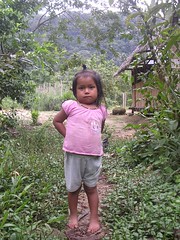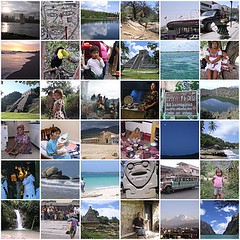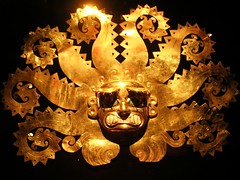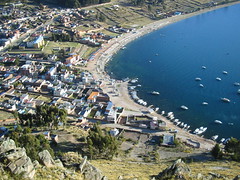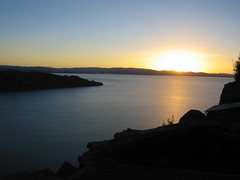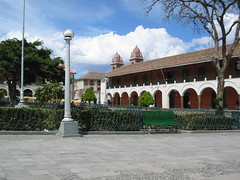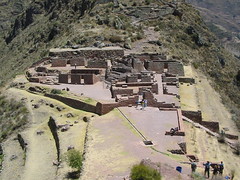Survival launched tribal voice, a project to share the thoughts and experiences of some of the most diverse societies on earth. The project starts with two tribes in Brazil: the Guarani, whose land has been devastated by farmers and ranchers, and the Yanomami. It’s time to listen and spread the word.
Nomadic travel’s Slideshow
A year ago began the adventure of this blog… a mosaic of emotions in the deepest heart of the American continent. We have interiorized a magical world, sometimes so complex to be hardly understood. From United States, thinking head of the world as it is nowadays, we have learned to leave aside preconceptions and replace them with curiosity. Mexico has donated to us the immense joy of the travel, endless horizons and the beauty of nature, but also the inexhaustible resistance of a people seduced and then abandoned. Guatemala, wonderful and moving, fertile land of the Mayan world, the search for a better future, that we joined through our cooperation as volunteers. Colombia, an oceanic and magnificent country, so wild to escape everyone’s look; the surprise of an electrifying ferment of lives. Ecuador, synthesis of the whole latinoamerican style, a luxuriant nature and pleasant people: the encounter with the Amazonian rain forest and its peoples, the eternal fight against the exploitation with no rules of the natural resources. Peru with its archaeological beauties, in the undiscovered northern Andean region; the emotion of the “suiza peruana” (Peruvian Switzerland), Huaraz and the Cordillera Blanca. Now we fall asleep on the last day, an ethnic mosaic of faces and looks smiles to us, the importance that they have had and they will have in our life, the promise to meet us another time, one day…
Lima and Manual del Pendejo
The last American week, once more and so short to seem already ended: the travel through Peru, fantastic but perhaps lived less intensely regarding the adventures in the other Latin American countries. Coming from the uncovered coast of the Pacific Ocean, Lima appears as an enormous and dusty strip of desert, at first sight quite unattractive. The traffic congests this big city reducing the historical center (around Plaza de Armas) to a funnel of smog, nothing romantic. People shout in order to sell goods of any type, from food to the most unthinkable objects. An old man shows us his product, saying “asì me gano la vida“, the Manual del Pendejo, that is expired daydreams and holy water… life in Latin America is never banal neither sweet, just demands a lot, maybe too much creativity.
The Yuyanapaq.Para recordar museum (in memory of the two decades civil war, 1980-2000), remembers through an intense audiovisual exposition, that tragic period in Peruvian history and the sad genocide of the Andean people, a season of ideological contrasts that kicked up a big wave of terror in the country. As always, those who paid the worst price in this war were the indigenous people, particularly in the region of Ayacucho. Overwhelmed by a spiral of violence and terroristic actions, the country lost the conscience and suspended its own history.
Bolivia, the rebel (and indigenous)
Thinking about the last week’s news coming from Bolivia (nationalization of the energetic resources), I was placing in doubt the ability of the Bolivians (and in general of Latin Americans) to positively take advantage of this opportunity, in order to involve in this process the indigenous movements. An article published on Selvas.org highlights this same issue, indicating the active participation of the movements as the fundamental step to assure that the political decisions could be built on sustainable and environmental friendly basis.
Bolivia, the rebel
“Let’s begin from hydrocarbons, then it will be the time of the mines, therefore of the forests, and of all the natural resources that have left our ancestors to us. Finally, it will be the time of the earth that is for all the Bolivians” has said Evo Morales.
I do not have the role to criticize or to exalt the decision of the president of Bolivia to nationalize the resources of his country, decision which was largely preannounced, but I have got too many Bolivian friends not to know that this is a day of rave-up for them, a day that they dreamed for a long time, an unforgettable day. Unfortunately the game they are playing is so hard, the energy demand is so insatiable that we should at least expect a journalistic and/or ideological reprisal against this splendid Latin American country. And the history tells us the rest. Bolivia, if I can, it’s time you turn your free and raffish look to your fair culture, to your immense forests, to your beauty, don’t lose your way along paths that smell of oil…
Isla del Sol and Tiwanaku
In the religion of the Incas, it was believed that the sun god was born here. And with reason. The Isla del Sol is beatifully positioned in the Bolivian side of the Lake Titicaca.
Left the Lake Titicaca and Isla del Sol, in the direction of La Paz, the Tiwanaku unesco site lies in the middle of the andean highlands, surrounded by semi-desertic landscape and dominated by some of the highest and most magnificient andean peaks (Janq’u Uma, Illampu, Huayna Potosi, Illimani). The site is worldwide famous for being the inauguration speeches of Evo Morales, in front of the gateway of the sun and for being a highly spiritual place, representing the vision of a world centered on the tradition and matriarcal social footprint of the indigenous peoples.
The dream of Copacabana
Welcome to Bolivia! The dream at the heart of Latin America, a country that has been able to chart a course in history, sinking its roots in the ancient rites of the Pachamama, the mother earth. Bolivia, the land of the indigenous peoples who were able to offer an alternative, a new vision of the relationship between man and nature, man and natural resources. A country that still relies on the popular tradition and the syncretism as a remedy for the pains of daily life. Bolivia A colorful and musical tune with its contrasts, from the peaks of the Andes to the Amazon rainforest.
Tiwanaku is the symbol of the ancient origins of Bolivia, a meeting of diametrically opposed cultures, a meeting between the sun and the moon, where the extreme material poverty has always been balanced by a huge spiritual wealth. On one side the Lake Titicaca, the Isla del Sol and the bolivian Copacabana. On the other side La Paz and the Yungas, coming soon. Bolivia, a hope for all the souths of the world.
Sunset on Lake Titicaca
Lake Titicaca is breathtaking for its extreme beauty and not only for the altitude of over 3800 meters above sea level. From Ayacucho, an endless journey that leads first on the coast of the Pacific Ocean in Pisco, Ica and Nazca, Arequipa and finally the return to the Andean plateau, between Juliaca and Juli, two villages on the shores of Lake Titicaca.
Along the lake you can discover enchanted places, breathtaking views and an ancient culture that has its roots in symbiosis with the lake Titicaca. On the horizon you can see some Uros settlements, built on islands made of cane and that can be reached with the typical canoes also made of cane. A sunset on Lake Titicaca is worth a trip. Soon it will be Bolivia.
Ayacucho and anticucho
From Andahuaylas the road continues uncertain between steep climb up to the 5000 meters of the plateau and steep descents to lick the Amazon rain forest, along the valley of Chanka and the tributaries of the Rio Apurimac. Finally we arrive to Ayacucho, abandoned pearl between indigenous culture, religiosity and syncretism, sendero luminoso.
Ayacucho, the city of many Peruvian friends, also on their way to some fascinating and exotic places. Ayacucho, the city of the best anticuchos or offal of bovine and grilled potatoes and best picarrones or pancakes with a special sauce.
Incas land, Cusco and Pisac
Getting to Cusco when the last rays of sun lapping the weary slopes of the valley of the Incas is one of the dreams of every traveler. Cusco is a living testimony of the countless stories of glory and defeat that were woven into the long night of the five hundred years. Breathtakingly beautiful, proud as its indigenous population, but then defeated and disfigured for punishment. Now again a crossroad for pilgrims from around the world, coming to admire the past.
The sunlight beats long adventurous days, moving along the land of the Incas, from Cusco to Abancay, passing through the spectacular ruins of Pisac, less visited but not less spectacular than the nearby mysterious Machu Picchu. The Sacred Valley of the Incas is the valley of the Urubamba River in the Peruvian Andes and was the heart of the Inca civilization. The valley was appreciated for its special geographical and climatic qualities, for its natural resources and for the production of corn. The ruins of Pisac give a feeling of ownership of the mountain, thrilling extreme slopes, vertigo; these stones breathe a nearly thousand-year history, unparalleled perfection, unique harmony.
